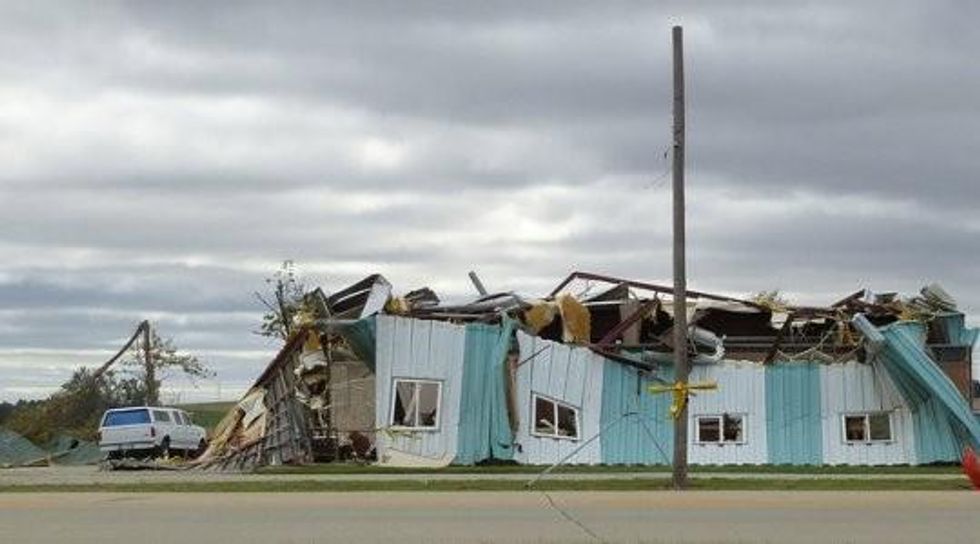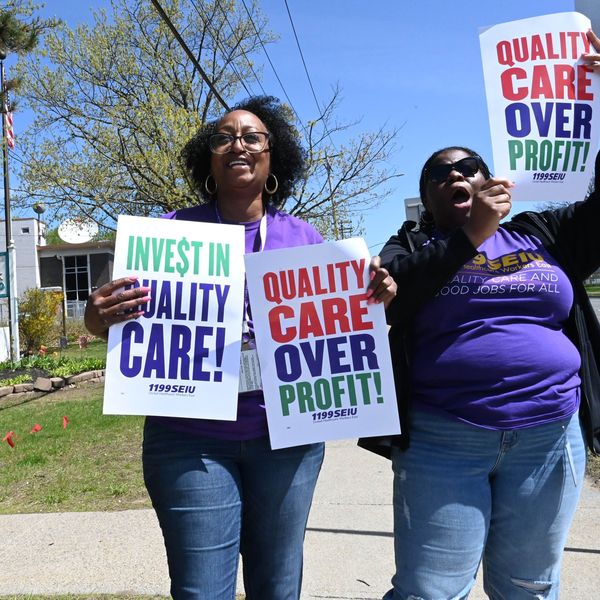'Weather-Palooza' Wallops Nation Over Weekend
It was a weekend of extreme, wild weather across the nation.
Weather historian Christopher C. Burt wrote on Friday:

Weather historian Christopher C. Burt wrote on Friday:
For what may be the first time in modern records, the contiguous U.S. is facing a simultaneous threat from a tropical storm landfall, blizzard, tornado outbreak, and extreme wild fire event. Or, as Chrissy Warrilow of The Weather Channel put it, a veritable Weather-Palooza (a 'Palooza' is a musical event featuring four or so major acts performing at the same time).
While tropical storm Karen weakened and was downgraded to a tropical depression on Saturday, Burt notes that it contributed to flooding in Louisville, Kentucky, which was hit with nearly seven inches of rain, the "2nd greatest 24-hour precipitation event in the city's modern history."
A storm system walloped the Great Plains with tornadoes and thunderstorms while bringing a blizzard to Wyoming and South Dakota. Wayne, Nebraska may have been the area most heavily hit by a tornado, and the National Weather Service has called the twister that whipped through the town on Friday an EF4 tornado, one that has wind speeds of 166 to 200 mph. Meanwhile, at least 33 inches of snow fell in South Dakota's Black Hills, while four feet of snow, a record breaker for this time of year, fell in the South Dakota town of Deadwood.
Brett Anderson, a senior meteorologist with AccuWeather, said, "It is not all that unusual to have significant snow in the Rockies and Black Hills this time of year, but it is rare to have snowfall measured in feet in early October."
Another part of the wild weather trifecta that hit the nation this weekend was in California, where hurricane-force winds and unseasonably high temperatures helped fuel several wildfires. The National Weather Service called the situation the region's "most significant fire weather threat in the past five years."
While climate change was not mentioned in corporate media reports covering the extreme events of the past several days, a report last month from the National Oceanic and Atmospheric Administration (NOAA) echoed previous studies in linking extreme weather events to human-caused climate change.
* * *
Photos from some Twitter users show some of the extreme weather:
\u201cThe Rapid City, S.D., weather service office is calling last weekend's blizzard a 'megastorm.' https://t.co/Pg4doTBDyH\u201d— MPR News (@MPR News) 1381169579
\u201c#DeLuzFire on Camp Pendleton as seen from Sleeping Indian Road area near Fallbrook.\u201d— Sarah Burge (@Sarah Burge) 1381024883
___________________
An Urgent Message From Our Co-Founder
Dear Common Dreams reader, The U.S. is on a fast track to authoritarianism like nothing I've ever seen. Meanwhile, corporate news outlets are utterly capitulating to Trump, twisting their coverage to avoid drawing his ire while lining up to stuff cash in his pockets. That's why I believe that Common Dreams is doing the best and most consequential reporting that we've ever done. Our small but mighty team is a progressive reporting powerhouse, covering the news every day that the corporate media never will. Our mission has always been simple: To inform. To inspire. And to ignite change for the common good. Now here's the key piece that I want all our readers to understand: None of this would be possible without your financial support. That's not just some fundraising cliche. It's the absolute and literal truth. We don't accept corporate advertising and never will. We don't have a paywall because we don't think people should be blocked from critical news based on their ability to pay. Everything we do is funded by the donations of readers like you. Will you donate now to help power the nonprofit, independent reporting of Common Dreams? Thank you for being a vital member of our community. Together, we can keep independent journalism alive when it’s needed most. - Craig Brown, Co-founder |

Weather historian Christopher C. Burt wrote on Friday:
For what may be the first time in modern records, the contiguous U.S. is facing a simultaneous threat from a tropical storm landfall, blizzard, tornado outbreak, and extreme wild fire event. Or, as Chrissy Warrilow of The Weather Channel put it, a veritable Weather-Palooza (a 'Palooza' is a musical event featuring four or so major acts performing at the same time).
While tropical storm Karen weakened and was downgraded to a tropical depression on Saturday, Burt notes that it contributed to flooding in Louisville, Kentucky, which was hit with nearly seven inches of rain, the "2nd greatest 24-hour precipitation event in the city's modern history."
A storm system walloped the Great Plains with tornadoes and thunderstorms while bringing a blizzard to Wyoming and South Dakota. Wayne, Nebraska may have been the area most heavily hit by a tornado, and the National Weather Service has called the twister that whipped through the town on Friday an EF4 tornado, one that has wind speeds of 166 to 200 mph. Meanwhile, at least 33 inches of snow fell in South Dakota's Black Hills, while four feet of snow, a record breaker for this time of year, fell in the South Dakota town of Deadwood.
Brett Anderson, a senior meteorologist with AccuWeather, said, "It is not all that unusual to have significant snow in the Rockies and Black Hills this time of year, but it is rare to have snowfall measured in feet in early October."
Another part of the wild weather trifecta that hit the nation this weekend was in California, where hurricane-force winds and unseasonably high temperatures helped fuel several wildfires. The National Weather Service called the situation the region's "most significant fire weather threat in the past five years."
While climate change was not mentioned in corporate media reports covering the extreme events of the past several days, a report last month from the National Oceanic and Atmospheric Administration (NOAA) echoed previous studies in linking extreme weather events to human-caused climate change.
* * *
Photos from some Twitter users show some of the extreme weather:
\u201cThe Rapid City, S.D., weather service office is calling last weekend's blizzard a 'megastorm.' https://t.co/Pg4doTBDyH\u201d— MPR News (@MPR News) 1381169579
\u201c#DeLuzFire on Camp Pendleton as seen from Sleeping Indian Road area near Fallbrook.\u201d— Sarah Burge (@Sarah Burge) 1381024883
___________________

Weather historian Christopher C. Burt wrote on Friday:
For what may be the first time in modern records, the contiguous U.S. is facing a simultaneous threat from a tropical storm landfall, blizzard, tornado outbreak, and extreme wild fire event. Or, as Chrissy Warrilow of The Weather Channel put it, a veritable Weather-Palooza (a 'Palooza' is a musical event featuring four or so major acts performing at the same time).
While tropical storm Karen weakened and was downgraded to a tropical depression on Saturday, Burt notes that it contributed to flooding in Louisville, Kentucky, which was hit with nearly seven inches of rain, the "2nd greatest 24-hour precipitation event in the city's modern history."
A storm system walloped the Great Plains with tornadoes and thunderstorms while bringing a blizzard to Wyoming and South Dakota. Wayne, Nebraska may have been the area most heavily hit by a tornado, and the National Weather Service has called the twister that whipped through the town on Friday an EF4 tornado, one that has wind speeds of 166 to 200 mph. Meanwhile, at least 33 inches of snow fell in South Dakota's Black Hills, while four feet of snow, a record breaker for this time of year, fell in the South Dakota town of Deadwood.
Brett Anderson, a senior meteorologist with AccuWeather, said, "It is not all that unusual to have significant snow in the Rockies and Black Hills this time of year, but it is rare to have snowfall measured in feet in early October."
Another part of the wild weather trifecta that hit the nation this weekend was in California, where hurricane-force winds and unseasonably high temperatures helped fuel several wildfires. The National Weather Service called the situation the region's "most significant fire weather threat in the past five years."
While climate change was not mentioned in corporate media reports covering the extreme events of the past several days, a report last month from the National Oceanic and Atmospheric Administration (NOAA) echoed previous studies in linking extreme weather events to human-caused climate change.
* * *
Photos from some Twitter users show some of the extreme weather:
\u201cThe Rapid City, S.D., weather service office is calling last weekend's blizzard a 'megastorm.' https://t.co/Pg4doTBDyH\u201d— MPR News (@MPR News) 1381169579
\u201c#DeLuzFire on Camp Pendleton as seen from Sleeping Indian Road area near Fallbrook.\u201d— Sarah Burge (@Sarah Burge) 1381024883
___________________

